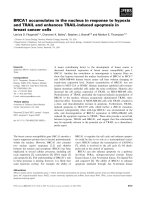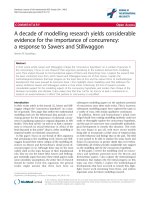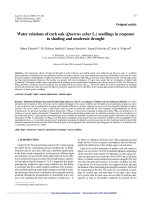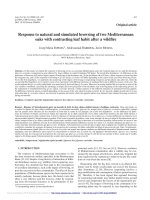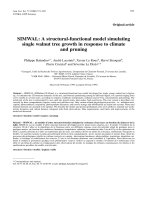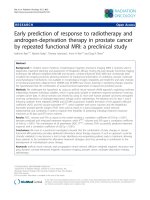Investor response to zero and small positive earnings surprises
Bạn đang xem bản rút gọn của tài liệu. Xem và tải ngay bản đầy đủ của tài liệu tại đây (495.38 KB, 107 trang )
INVESTOR RESPONSE TO ZERO AND SMALL POSITIVE
EARNINGS SURPRISES
LIN ZHIXING
(B. Econ. Xiamen University, China)
A THESIS SUBMITTED
FOR THE DEGREE OF DOCTOR OF PHILOSOPHY
DEPARTMENT OF FINANCE AND ACCOUNTING
BUSINESS SCHOOL
NATIONAL UNIVERSITY OF SINGAPORE
2006
i
ACKNOWLEGEMENTS
First and foremost, I would like to express my sincere gratitude to my supervisor,
Associate Professor Michael Shih, for his professional guidance and support
throughout my five years of study at the National University of Singapore. I truly
appreciate the contribution of my dissertation committee members, Associate
Professor Inmoo Lee and Assistant Professor Mujtaba Mian.
I would like to express my special thanks to Associate Professor Srinivasan
Sankaraguruswamy and Associate Professor Trevor Wilkins for their insightful
comments. I am indebted to the participants in the workshop and seminars at the NUS
for their valuable comments and suggestions. I also want to thank my fellow Ph.D.
students for their support and companionship.
Last but not least, I wish to express my deepest appreciation to my family for
always being supportive of my efforts in pursuing the Ph.D.
ii
TABLE OF CONTENTS
Pages
Acknowledgements ………………………………………………………………….i
Summary… ……………………………………………………………………… iv
List of Tables…………………………………………………………………………v
List of Figures……………………………………………………………………… vi
Chapters:
1. Introduction………………………………………………………………… 1
2. Literature Review…………………………………………………………….7
3. Hypothesis Development………………………………………….………14
4. Research Design and Sample……………………………………… ….20
4.1 Research Design……………………………………………… 20
4.1.1 Primary Test Model……………………………… 23
4.1.2 Non-linear Model……………………….………… 25
4.2 Data and Sample……………………………………………… 26
4.2.1 Sample Selection…………….………………… 26
4.2.2 Descriptive Statistics……………………………….27
4.3 Preliminary Evidence.……………………………… ………… 28
5. Main Results……………………………………………………………… 37
5.1 Skepticism towards a Zero or Small Positive
Earnings Surprise………… ………………… 37
5.1.1 Lower ERC for Zero and
Small Positive Earnings Surprises.………………37
5.1.2 Non-linear Regression…………………… …… 42
5.1.3 Regression with Control Variables…………… 43
iii
5.1.4 Additional Tests…… …………… ………………45
5.2 Further Evidence…………… 47
5.3 Analyst Forecast Revisions…………… ………… …………54
6. Investor Response over the Subsequent Quarter… ……….……….72
6.1 Introduction………………………………………………… 72
6.2 Tests and Results…………………………………………… …77
6.2.1 Post-announcement CAR…………… ………….77
6.2.2 Regression Analysis…………………… ……… 78
6.2.3 Robustness Check………………………….… …82
6.2.4 Controlling for the Effects of DA…………….……84
7. Conclusions………………………………………………….……… 92
Bibliography………………………………………………………… …………….95
iv
SUMMARY
Evidence in prior research suggests that firms that manipulate earnings and/or analyst
earnings expectations are likely to report earnings that precisely meet or narrowly beat
analyst earnings forecasts, resulting in a zero or small positive earnings surprise.
Investors, therefore, are likely to be more skeptical of a zero or small positive
earnings surprise in their attempt to identify possible manipulators on the earnings
announcement date. I test the hypothesis by comparing the earnings response
coefficients (ERCs) across ranges of earnings surprises. I find that the ERC is lower
for zero and small positive earnings surprises than the ERCs for earnings surprises in
adjacent ranges. The result is consistent with investors seeing a zero or small positive
earnings surprise in and of itself as an indication that manipulation has occurred. By
comparing the relation between analyst revisions of next-quarter earnings and the
current-quarter earnings surprise across ranges of earnings surprises, I also find
evidence that analysts regard zero or small positive earnings surprises as the results of
manipulations, and respond negatively to such earnings surprises.
I further examine abnormal stock returns in a post-earnings announcement period
in which full balance sheet data are released. Negative CARs are associated with zero
and small positive earnings surprises, suggesting that while investors are skeptical of
a zero or small positive earnings surprise on the earnings announcement date, they
underestimate the probability that such an earnings surprise is achieved via earnings
management on that day and/or the extent to which earnings management contributes
to such earnings surprises.
v
LIST OF TABLES
TABLES PAGES
4.1 Sample Selection……………………………………………………… ……32
4.2 Means of Variables for Earnings Surprises in Various Classes…………… 33
4.3 Mean CAR[-1,1] for Zero and Small Positive
Earnings Surprises across Years………………………………… …………34
5.1 Regression of CAR[-1,1] on the Earnings Surprise………………… …… 59
5.2 Regression of CAR[-1,1] on the Earnings Surprise (by Year)……………….60
5.3 Regression of CAR[-1,1] on the Earnings Surprise with Time Trend…….….61
5.4 Non-linear Surprises-Return Regression …………………………………….62
5.5 Regression of CAR on the Earnings Surprise with Control Variables……….63
5.6 Regression of CAR on the Earnings Surprise (the Most Recent
Single Analyst Forecast as Analyst Earnings Expectations)…………………65
5.7 Regression of CAR on the Earnings Surprise
(Scaled by Absolute Actual Earnings)……………………………………… 66
5.8 Regression of CAR on the Earnings Surprise Controlling for
the Effects of Positive Discretionary Accruals and Downward
Analyst Forecast Trajectory………………………………………………… 67
5.9 Regression of Forecast Revisions for Next Quarter
on the Earnings Surprise of Current Quarter…………………………………68
5.10 Regression of Forecast Revisions for Next Quarter on the Earnings
Surprise of Current Quarter Controlling for the Effects of Positive
Discretionary Accruals and Downward Analyst Forecast Trajectory… …… 69
6.1 Descriptive Statistics and Correlation Coefficients………………………… 86
6.2 Regression Analysis of Post-announcement Returns…………………… …87
6.3 Regression Analysis of Post-announcement Returns
(The Most Recent Single Analyst forecast)…………………… …. ……….88
6.4 Regression Analysis of Post-announcement Returns Controlling
Investor Response to Discretionary Accruals………………………… ……89
vi
LIST OF FIGURES
FIGURES PAGES
4.1 Mean and Median CAR[-1,1] for Zero Earnings Surprises and the
Ratio of Number of Earnings Surprises in the [-1¢, 0) Range to
Number of Earnings Surprises in the [0¢, 1¢] Range in 1992-2004…………35
4.2 Mean and Median Adjusted CAR[-1,1] for Small Positive
Earnings Surprises and the Ratio of Number of Earnings Surprises
in the [-1¢, 0) Range to Number of Earnings Surprises in
the [0¢, 1¢] Range in 1992-2004…………………………………………… 36
5.1 Variation of ERC across Earnings Surprises Ranges ……………………… 70
5.2 ERC for Zero and Small Positive Earnings Surprises and the Ratio
of Number of Earnings Surprises in the [-1¢, 0) Range to Number of
Earnings Surprises in the [0¢, 1¢] Range in 1992-2004………………… …71
6.1 Cumulative Abnormal Returns in the Event Window [+2, +60]
after Earnings Announcement……………………………………………… 90
- 1 -
CHAPTER 1
INTRODUCTION
The accounting literature documents significant discontinuities around zero in the
distributions of forecast errors (Degeorge et al. 1999, Abarbanell and Lehavy 2003,
Burgstahler and Eames 2006,). The findings are generally referred to as a “number
game” played by managers and analysts. That is, managers manipulate earnings
upward or guide forecasts downward so as to meet or beat analyst forecasts with the
intention to reap the financial and capital market benefits associated with meeting or
beating analyst forecasts (Matsunaga and Park 2001, Bartov et al. 2002). Investors,
however, are not entirely silent on the “number game”. Bartov et al. (2002) and Lopez
and Rees (2002) show that reduced capital market premium is associated with
suspected cases of meeting analyst forecasts through earnings management. Both
Bartov et al (2002) and Lopez and Rees (2002) rely upon discretionary accruals
estimated from Jones-type models. However, it is still not clear how investors respond
to the “number game” at the time of earnings announcement when balance sheet
information is not yet available to investors to evaluate possible earnings management.
How do investors identify cases of earnings management at the time of earnings
announcement? Do investors learn from academic research and industry press on the
“number game” played by mangers and analysts? This study attempts to shed light on
these research questions by examining investor response to the discontinuity around
zero in the forecast-error distribution around earnings announcement date.
- 2 -
It is costly for firms to manipulate earnings or analyst earnings expectations
(Degeorge et al. 1999). Thus, firms would not find it to their advantage to manipulate
earnings and/or expectations to the extent that reported earnings beat analyst
expectations by a large margin. It benefits them more to manipulate earnings and/or
expectations just enough to allow reported earnings to precisely meet or narrowly beat
analyst earnings forecasts, resulting in zero or small positive earnings surprises. This
argument is supported by the empirical evidence in Degeorge et al. (1999) and
Abarbanell and Lehavy (2003), which shows abnormally high concentrations of
observations just above analyst earnings expectations and abnormally low
concentrations just below them.
This study examines how investors respond to zero and small positive earnings
surprises. I first investigate the possibility that investors rely on “a zero or small
positive earnings surprise” as a simple yet effective clue to identify possible
manipulators on the earnings announcement date. Investors may rationally regard
firms reporting zero or small positive earning surprises as possible manipulators and
respond unfavorably. I test this hypothesis by comparing investor response to zero and
small positive earnings surprises relative to earnings surprises in adjacent ranges.
Investor response to earnings surprises in each range is measured by the coefficient in
the regression relating abnormal stock returns to the earnings surprise, or the earnings
response coefficient (ERC). If investors associate a zero or small positive earnings
surprise with manipulation, the ERC for zero and small positive earnings surprises
should be lower than the ERCs for earnings surprises in adjacent ranges. This is
because zero and small positive earnings surprises that are the result of earnings
management are less indicative of the firm’s profitability and likely to be followed by
- 3 -
lower future cash flow, and consequently are likely to be associated with a weaker
investor response and a lower ERC. Zero and small positive earnings surprises that
are the result of analyst expectations management have lower surprise content, and
therefore are likely to be associated with a lower ERC as well.
I conduct the analysis based on data of firm-quarters in 1992-2004. To investigate
the temporal change in investor response, I also examine the 1992-1997 and 1998-
2004 periods separately. Tests using the full sample show that ERC is an inverted U
shaped function of the earnings surprise, with extreme earnings surprises associated
with smaller ERCs than moderate earnings surprises. The result is consistent with
prior studies suggesting that abnormal stock returns are an S-shaped function of the
earnings surprise (see Freeman and Tse 1992; Kinney et al. 2002). More importantly,
zero and small positive earnings surprises are associated with a significantly lower
ERC than are earnings surprises in adjacent ranges. This is consistent with the notion
that investors are more skeptical of zero or small positive earnings surprises and
impose a penalty on firms reporting such earnings surprises. Interestingly, this result
holds only for firm-quarters in 1998-2004, but not those in 1992-1997, a pattern
which suggests that investor skepticism toward a zero or small positive earnings
surprise is a fairly recent phenomenon, probably instigated by public figures
denouncing firms managing earnings and/or analyst expectations (e.g., Arthur Levitt’s
1998 famous speech) and frequent press reports as well as academic research on the
prevalence of this practice in late 1990s. I also explore the time-series trend of the
ERC for zero and small positive earnings surprises. I document that the yearly ERC
for zero and small positive earnings surprises is decreasing over the entire sample
period, and is significantly related to the ratio of small misses over meets and small
- 4 -
beats which captures management’s propensity to meet or beat analyst forecasts.
1
This
result provides strong support for the connection between the lower ERC for zero and
small earnings surprise and management’s tendency to meet or beat analyst forecasts.
In addition, I rule out the possibility that the results are not explained by investor
skepticism towards a zero or small positive earnings surprise, but rather by my failure
to control for firm attributes that also affect the ERC. Prior research (e.g., Bartov et al.
2002) shows that the ERC is affected by the sign of estimated discretionary accruals
and the change in analyst earnings forecasts over time. Controlling for these variables
in my test does not change the results.
2
This suggests that investors see a zero or
small positive earnings surprise as a red flag in and of itself. In other words, the fact
that the firm reports a zero or small positive earnings surprise has incremental
information content about whether manipulation has occurred over and above other
signs of manipulation.
Also, I examine analyst revisions of the earnings forecasts for the next quarter
after the announcement of the current quarter’s earnings. I observe a positive relation
between analyst revisions of earnings forecasts for the next quarter and the earnings
surprise of the current quarter for all firm-quarters except those with a zero or small
positive earnings surprise. The result suggests that analysts also see a zero or small
positive earnings surprise as a red flag for manipulations and respond unfavorably to
such earnings surprises.
I further examine abnormal stock returns of firms reporting a zero or small
positive earnings surprise in a post-earnings-announcement period during which
1
The lower the ratio, the more likely managers are engaged in manipulations to avoid reporting negative earnings
surprises.
2
I obtain this result, although, as I explain in the text, the test results are biased against finding a lower ERC for
zero and small positive earnings surprises than ERCs for earnings surprises in other ranges.
- 5 -
balance sheet data are released. I find that zero and small positive earnings surprises
are associated with negative returns in the post-earnings-announcement period,
indicating that investors further penalize firms reporting a zero or small positive
earnings surprise when balance sheet data enable them to tell with greater certainty
whether these firms indeed have managed earnings and the extent of earnings
management. I interpret the result as suggesting that while investors see a zero or
small positive earnings surprise as a red flag on the earnings announcement date, they
underestimate the probability that such an earnings surprise is achieved via earnings
management on that day and/or the extent to which earnings management contributes
to such earnings surprises.
This study makes a contribution to the literature by shedding new light on how
investors and analysts identify manipulators of earnings and analyst expectations.
Prior research (Bartov et al. 2002; Defond and Park 2001) suggests that investors and
analysts do so based on “hard evidence” that manipulation has occurred, i.e., positive
estimates of abnormal working capital or discretionary accruals, or a downward
analyst forecast trajectory. I show evidence that investors and analysts also associate
certain firms with manipulation even in the absence of hard evidence. A mere
closeness of the reported earnings to the earnings benchmark is sufficient to trigger
suspicions and negative reactions from investors and analysts. This study thus
advances our understanding of how the game described by Degeorge et al. (1999)
between firms on one side and analysts and investors on the other is played.
This study also provides first evidence that great publicity of firms manipulating
earnings and/or analyst expectations has increased investor awareness and intensified
their efforts to identify the wrong-doers. While evidence suggests many firms meet or
- 6 -
beat earnings benchmarks through illegitimate means starting from early 1990s
(Brown 2001, Matsumoto 2002), it appears that investors had not started to penalize
firms with a zero or small positive earnings surprise until late 1990s, i.e., after being
exposed to frequent news reports on improper accounting practices and public
denunciations of such practices by regulators and public figures.
The rest of the thesis is organized as follows. Chapter 2 reviews prior related
studies, which lead to the hypotheses proposed in Chapter 3. Chapter 4 outlines the
test methodology and describes the sample collection process, followed by Chapter 5
which presents and discusses the main results. Chapter 6 then investigates investor
response to zero and small positive earnings surprises after earnings announcement
date. Chapter 7 presents the concluding remarks.
- 7 -
CHAPTER 2
LITERATURE REVIEW
Prior studies provide earnings management evidence based on accruals or
discretionary accruals (e.g., Healy 1985, Jones 1991, Dechow et al. 1995), and real
activities (e.g., Baber et al. 1999, Dechow and Sloan 1991, Bushee 1998). Another
popular approach relies exclusively on the distribution of reported earnings. Hayn
(1995) is the first to document the abnormally higher concentrations of cases just
above zero earnings, and the abnormally lower concentrations of cases just below
zero earnings. She interprets the finding as evidence consistent with managers
manipulating earnings to surpass the “red line”. Burgstahler and Dichev (1997) also
find similar discontinuities around zeros in the distributions of annual earnings levels
and annual earnings changes. The authors show that about 9%-12% of firms with pre-
managed earnings below earnings of previous year manage the numbers to report an
earnings increase, and that about 30%- 44% of firms with pre-managed earnings
below zero manage earnings to report a positive number. Degeorge et al. (1999) find
discontinuities around zero EPS, zero change in EPS, and zero analyst forecast errors,
suggesting that managers tend to manage earnings to exceed the three thresholds.
Moreover, the authors find that managers set priority of meeting one threshold over
meeting another. Managers first seek to meet zero earnings, and then earnings of the
prior corresponding period, and lastly analyst earnings forecasts. In other words,
avoiding losses and earnings decreases seems to be the most important goal that
- 8 -
managers seek to achieve in their sample period. Consistent with the findings in
Degeorge et al. (1999), Brown and Caylor (2005) find the same managerial threshold
hierarchy in the years from 1985 to 1995. However, they find a shift in the managerial
threshold hierarchy after 1995. Analyst forecasts have become the most important
threshold that managers seek to meet since 1996. They argue that the shift in the
managerial threshold hierarchy is caused by the shift in the valuation consequences of
meeting different thresholds. In recent years, the market rewards firms more for
avoiding negative quarterly earnings surprises than for avoiding losses and earnings
decreases. Managers thus took the cue from capital markets and re-order the quarterly
earnings thresholds. Evidence of increasing managers’ tendency to meet or beat
analyst earnings expectations is also provided in Brown (2001), Bartov et al. (2002),
Lopez and Rees (2002), and Matsumoto (2002), all of which show that the percentage
of positive earnings surprises has been increasing in recent years.
The discontinuities in the distributions provide evidence consistent with earnings
management, but do not reveal how the earnings are managed. To provide direct
evidence of earnings management, researchers investigate how managers reach the
earnings targets. Several studies provide evidence of earnings management to meet
analyst forecasts based on discretionary accruals estimated from Jones type models.
Burgstahler and Eames (2006) show that firm-years with zero forecast errors exhibit
more positive discretionary accruals than firm-years in the adjacent categories. Payne
and Robb (2000) show that firms tend to report positive discretionary accruals when
firms’ pre-managed earnings (earnings before discretionary accruals) are below
analyst consensus forecasts. Matsumoto (2002) shows that positive discretionary
accruals are associated with a higher probability of meeting or beating analyst
- 9 -
forecasts, consistent with managers manipulating accruals to avoid negative earnings
surprises. Moreover, Abarbanell and Lehavy (2003) find that the higher frequency of
small positive forecast errors relative to small negative forecast errors (the middle
asymmetry) disappears after reported earnings component of the earnings surprise is
stripped of discretionary accruals. More recently, Ayers et al. (2006) find a stronger
positive association between discretionary accruals and beating analyst forecasts than
other pseudo unexpected earnings targets (other points except zero in the analyst
forecast error distribution), providing strong support for earnings management to meet
or beat analyst earnings forecasts.
3
Many other studies provide earnings management evidence without relying upon
discretionary accruals estimated from Jones type models.
4
For example, Barton and
Simko (2002) find that firms with less earnings management constrains are more
likely to meet or beat analyst forecasts. The constrains are measured as net operating
assets over total sales to reflect the extent of previous earnings management, since the
balance sheet accounts accumulate all the prior effects of earnings management.
Dhaliwal et al. (2003) present evidence that firms manage income tax expense to meet
analyst forecasts. The authors show that firms decrease their annual effective tax rate
from the third quarter to the fourth quarter as earnings (before tax expense
management) fall short of the consensus forecast. Moehrle (2002) finds that managers
are more likely to reverse restructuring charges when pre-reversal earnings fall below
3
However, Ayers et al. (2006) do not find stronger positive association between discretionary accruals and beating
zero earnings or previous period’s earnings than other pseudo earnings targets. Similarly, Dechow et al. (2003) do
no find accrual based earnings management evidence around zero earnings.
4
Many other papers present evidence of earnings management to meet or beat zero earnings and previous period’s
earnings. Phillips et al. (2003) show that the increase in deferred tax expense increases the probability of managing
earnings to avoid reporting an earnings decline and earnings loss, after controlling for abnormal accruals. Beaver et
al. (2003) show that property-casualty insurers with small positive earnings understate loss reserves relative to
insurers with small negative earnings. Beatty et al. (2002) provide earnings management evidence in the banking
industry.
- 10 -
analyst forecasts or below zero earnings. Managers may also manipulate real activities
to meet earnings thresholds in addition to managing accruals, as argued by
Roychowdhury (2005). These real activities include price discounts to temporarily
boost sales, overproduction to report lower cost of goods sold, and reduction of
discretionary expenditures.
5
She produces evidence consistent with her argument.
Zang (2005) find that there is a substitution effect between the accrual management
and real activity management and that managers employ these strategies sequentially:
managers select real earnings manipulation before resorting to accrual manipulation.
Bartov and Cohen (2007) show a decline in the use of expectations management and
accrual management, and no change in real earnings management in the Post-SOX
Period relative to the preceding seven-year period.
In addition to manipulating accruals and real activities, managers can also
manipulate core earnings by shifting the classification of items in the income
statements. McVay (2006) provides evidence that managers shifting between core
earnings and special items in order to meet analyst forecasts, as special items are
usually excluded from analyst earnings definition. The evidence is stronger for growth
firms, which have stronger incentive to meet analyst forecasts than value firms
(Skinner and Sloan 2002).
While majority of evidence is consistent with earnings management explanation,
some other studies offer alternative explanations for the discontinuities in the
distributions Dechow et al. (2003) propose several non-earnings-management
explanations, including (a) exchange listing requirements having a selection bias
towards profitable firms, (b) investors applying different valuation methods to profit
5
Other papers present earnings management to meet or beat the other two thresholds through manipulating cash
flow (Burgstahler and Dichev 1997; Bushee 1998).
- 11 -
versus loss firms and thus scaling earnings by market value accentuates (c) accounting
rules and conservatism precluding the recording of small losses and encouraging the
recording of small profits, and (d) the market-wide use of financial assets with return
distributions truncated at zero inducing a greater proportion of small profit firms.
Beaver et al. (2003) show that the asymmetric treatment of income taxes and special
items for profit and loss firms explains the discontinuity in the distribution of earnings
levels and earnings changes. Durschi and Easton (2005) find that market prices of
profit firms differ markedly from those of loss firms, which place one-cent per share
losses in earnings/price interval further from zero than one-cent per share profit. They
also show that the discontinuity in the frequency distribution of I/B/E/S/ annual actual
EPS and change in EPS is due to the fact that the proportion of firms with small losses
that are followed by I/B/E/S/ is much smaller than the proportion of firms with small
profits that are followed by I/B/E/S. The authors further show that forecast errors tend
to be much greater when analysts are optimistic than when they are pessimistic,
leading to discontinuity at zero in the forecast error distribution. The authors therefore
caution against using discontinuities in the distributions as ipso facto evidence of
earnings management.
While researchers have divergent opinions regarding to how to interpret the
discontinuity in the distributions, the question of how investors perceive the
discontinuity is relatively less explored in the literature. Xue (2004) examines the
market reactions to firms’ beating or missing zero earnings and previous period’s
earnings. She finds that after controlling for earnings levels and earnings surprises, the
abnormal returns around the earnings announcement dates of firms reporting small
profit or earnings increases are significantly higher than returns of firms just missing
- 12 -
the two thresholds. Her findings are consistent with managers manipulate earnings
around thresholds to signal future performance. However, Xue (2004) does not
investigate how investors respond to meeting or narrowly beating analyst forecast. As
analyst forecasts have become the most important earnings targets managers are
intended to meet (Brown and Caylor 2005), how investors respond to manipulations
to meet or beat analyst forecasts deserve some attention. Bartov et al. (2002) show
that possible earnings management (to meet analyst forecast) cases are associated
with statistically significantly but economically insignificantly lower premium. The
possible earnings management cases are defined as firms-quarters that report earnings
meeting or beating analyst forecasts (referred as MBE) but fail to maintain MBE
designation after adjusting for discretionary accruals. The two discretionary accruals
measures the authors use are abnormal accruals estimated from Jones model and
abnormal portion of the non-operating accruals (accruals other than working capital
accruals, depreciations and amortization). Bartov et al. (2002) also find that the
capital market premium is reduced but still present for cases consistent with analyst
expectations management. The expectations-management cases are defined as firm-
quarters with negative forecasts errors (actual minus individual analyst forecast issued
at the beginning of the quarter) and zero or positive surprises (actual minus individual
forecast nearest to the earnings announcement date). Bartov et al. (2002) use
cumulative stock returns over a quarter from the day when the first analyst forecast is
issued after the earnings announcement of the previous quarter to the day after
earnings announcement. The return window extends to 50 days after earnings
announcement of the current quarter in the tests concerning discretionary accruals, to
allow enough time for investors to fully digest the accrual information. However, the
- 13 -
research question on how investors react to suspect cases at the time of earnings
announcement and how the reaction changes over time still remain unanswered. This
study attempts to fill this gap in the literature.
- 14 -
CHAPTER 3
HYPOTHESIS DEVELOPMENT
Earnings management is a dynamic game, in which managers can manipulate
earnings over multiple periods. In a simplified 2-period scenario in which managers
maximize their own benefits and outsiders reward managers based on whether they
meet or beat thresholds, Degeorge et al. (1999) predict that managers will borrow
future earnings and pump up earnings in the current period to surpass the threshold in
order to reap the benefits, if true earnings are just below the threshold. In the next
quarter, earnings may again fall short of market expectations and managers may face
the same incentive to borrow future earnings. However, it is not possible for managers
to consistently manipulate earnings upward without market finding out such
manipulations. Investors anticipate firms engaged in earnings management to
experience a significant price drop due to earnings management being found or
earnings growth created by manipulation not being sustained.
Managers can also manipulate earnings through many venues. Prior research
shows managers may manipulate earnings through accrual management (Matsumoto
2002), real economic activities (Roychowdhury 2005), or deliberate misclassification
of items within income statement (McVay 2006). Earnings management through
accrual manipulation may not have a real impact on firm operation but generally
requires changes in assumptions subject to auditor’s approval, particularly when
managers’ incentives to manipulate earnings are strong if true earnings are just below
- 15 -
the threshold. Real activity manipulations may be less subject to the auditor’s scrutiny
but are costly as they affect the firm operations. For example, cutting R&D may
severely affect the firm’s long term competitive edge. Thus, earnings management
comes with a cost. Moreover, earnings created through manipulation are less
sustainable and mask the true performance of the firm. For example, underestimating
bad debt allowance increases earnings in the current period, but may decrease
earnings of future periods when bad debt allowance restores to its normal balance.
Earnings created through cash flow management is also less sustainable: cutting
prices to boost sales in the current period dampens the demand for the next period and
leads customers to expect a similar price-cutting, resulting in lower future cash
inflows (Roychowdhury 2005); over-production of the current period reduces the cost
of goods sold in the current period but increases the cost of goods sold for the future
periods, which in turn, reduces future earnings (Thomas and Zhang 2002). So long as
investors believe earnings management occurs and such earnings management has
negative impact on the long-term firm performance, investors will discount the values
of the firms that have engaged in earnings management. Thus, positive earnings
surprises created by manipulating earnings are less predictive of future cash flow and
therefore should be associated with lower Earnings Response Coefficient (ERC), as
ERC is positively related to the persistency of future cash flow (Easton and Zmjewski
1989) under the condition that investors are able to identify manipulators.
However, it is difficult to identify firms that manipulate earnings and/or analyst
expectations even for academic researchers, and probably more so for investors.
Academic researchers often use discretionary accruals models to identify firms that
manage earnings (e.g., Healy 1985, Matsumoto 2002, Ashbaugh et al. 2003). These
- 16 -
models can be unreliable, as Dechow et al. (1995) and Kothari et al. (2005) show, and
may cause misidentifications in many cases. These models, moreover, require balance
sheet data, which in most cases are released weeks or even months after the earnings
announcement date. Balsam et al. (2002) show that only 7.3% of firms issue detailed
press release along with quarterly earnings, and only 2.8% of firms disclose balance
sheet information. Besides, as stated earlier, firms do not just manipulate accruals to
meet analyst earnings expectations; they also change real economic activities (e.g.,
R&D) in many cases (see Bushee 1998 and Cheng 2004). It is even more difficult, if
possible, to detect firms that alter real economic activities to meet earnings
expectations.
Academic researchers also have trouble identifying manipulators of analyst
expectations. Some studies identify expectations manipulators as firms for whom
analysts lower earnings forecasts before the earnings announcement date (e.g., Bartov
et al. 2002). But analysts may lower earnings expectations for various reasons, not
necessarily as a result of firms’ attempt to manipulate their expectations. Using this
approach to identify firms that manipulate earnings expectations may also lead to
misidentifications.
Therefore at the time of earnings announcement, it is an asymmetric information
situation in which managers are informed of how meeting or beatings are achieved
while investors are kept uninformed. Under the assumption that investors are able to
fully discount biased reports of managers, the theoretical paper by Milgrom and
Robert (1986) predicts a “skepticism equilibrium” in which the informed party
(managers) announces the most favorable report consistent with the true state, and the
uninformed party (investors) assumes the worst. Under the assumption that investors
- 17 -
are uncertain about the quality of managers’ report, Shin’s (1994) theoretical model
predicts that the value of firms is a function of investor skepticism towards the
disclosures of managers. One implication of Shin’s (1994) model is that other things
being equal, firms that investors have higher skepticism towards will have a lower
price/earnings ratio. Investors are likely to be more skeptical of cases where reported
earnings precisely meet or narrowly beat analyst forecasts. These cases are likely to
arouse suspicions because manipulations of earnings or analyst earnings expectations
could entail substantial costs to the firm. As upward earnings management involves
shifting accruals to the current period from future periods, it reduces earnings in the
future, making it more difficult for the firm to meet future earnings expectations. Also,
upward earnings management is likely to raise earnings expectations in the future,
further reducing the odds of meeting earnings expectations in the future. Managers
therefore will not find it advantageous to manipulate earnings to the extent that
reported earnings beat analyst expectations by a large margin. Nor will managers find
it advantageous to manipulate analyst expectations to the extent that they are
exceeded by reported earnings by a large margin, because doing so will gratuitously
increase stock price volatility as well as reduce the credibility of managers with
analysts. Empirical results in Degeorge et al. (1999) and Abarbanell and Lehavy
(2003) are consistent with the theory, showing more (fewer) firms than expected
meeting or narrowly beating (narrowly missing) earnings expectations. Researchers
therefore regard a zero or small positive earnings surprise as more likely a result of
earnings management. Balsam et al. (2002) use “zero and small positive surprises” as
one of their criteria in identifying possible cases of earnings management. Market
participants are also fully aware of the “number game”. For example, analysts
- 18 -
acknowledge that “there may be some added degree of pressure to do that (manage
earnings), given the market environment and how badly stocks are punished for
missing estimates."
6
Regulators, moreover, see a zero or small positive earnings
surprise as a red flag: “a pattern of narrowly meeting or exceeding analysts’ estimates
is among the characteristics that the Securities and Exchange Commission uses in
identifying possible accounting irregularities” (Bryan-Low 2002). Learning from the
above sources, investors are likewise more skeptical of a zero or small positive
earnings surprise than larger earnings surprises. In other words, the fact that a firm
reports a zero or small positive earnings surprise has incremental information content
about whether manipulation has occurred over and above other signs of manipulation
such as positive estimated discretionary accruals. I therefore predict:
Hypothesis 1: Investors perceive a zero or small positive earnings surprise to be more
likely the result of earnings and/or analyst expectations management on the earnings
announcement date. Thus, stock price reactions to such earnings surprises during the
earnings announcement window are likely to be weaker than expected.
To the best of my knowledge, the hypothesis has never been tested in prior studies,
either directly or indirectly. Bartov et al. (2002) show the price reactions are affected
by the sign of estimated discretionary accruals and the trajectory of analyst earnings
forecasts over time. They do not investigate whether investors rely on a simple clue –
a zero or small positive earnings surprise – to identify possible manipulators. Their
tests, moreover, are based on abnormal returns accumulated over a period starting
from the announcement of the previous quarter’s earnings. In their tests on whether
6
See “a penny shaved is a penny earned” Business Week (August 6
th
, 2001).

